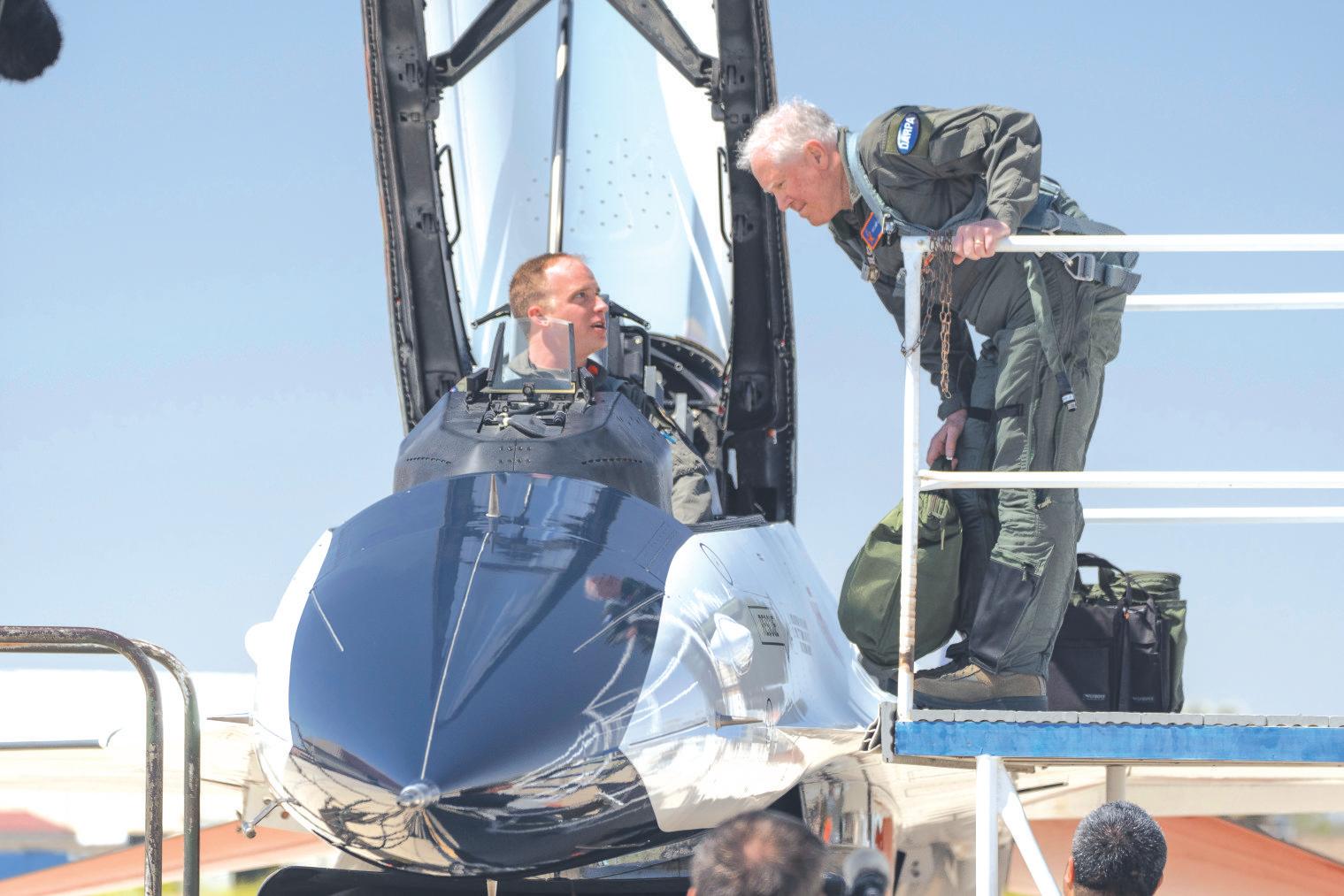MAVS
outside criticism directed at the 26year-old. Tatum was aware of pointed comments made about everything from his shot selection to leadership. But with so much at stake, he’s not worrying about whether he’s being respected.
“My job is to be the best player that I can be for our team on any given night,” Tatum said. “Yeah, I would love to make every shot I take. I know I can shoot better, and I will. At this time of the season, as long as we win and we’re trending in the right direction, I know my scoring will come. I’ve done that plenty of times “I just try to impact the game in other ways and just dominate. Dominate the game and not just be defined as a scorer.”
Along with his points, the Mavericks are counting on Doncic’s healing powers to be ready for Game 4 on Monday night.
Already slowed by a sprained knee and bad ankle, he has added a sore back to his long list of ailments after taking a hard fall in the final minutes of Game 3.
Doncic undoubtedly will push himself to play, but the Mavericks, who got 27 points from P.J. Washington Jr. in Game 3, are confident they can win without him.
“We’ve been here before, we’re not built on one guy,” coach Jason Kidd said. “We’re built on a team. ... It’s not golf where we just have a player and a caddie. This is a group that believes that if somebody is hurting, they are going to pick them up.”
CELTICS AT CAVALIERS
Boston leads, 2-1. Game 4, 6 p.m., TNT
NEED TO KNOW: Maybe it’s due to a sense of urgency or desperation, but the Celtics seem more comfortable on the road in the playoffs. A somewhat surprising 14-14 at home over the past three postseasons, they are 17-7 outside of Boston and 3-0 this year. ... After a competitive first quarter in Game 3, the Cavs couldn’t keep up with the Celtics, who led for 42 minutes.
KEEP AN EYE ON: Mitchell. While he’s not complaining about a lack of support, it’s becoming more apparent the Cavs don’t have enough complementary pieces around him to challenge for a title. Mitchell has been sensational, averaging 36.8 points in his last five games. But he’s having to shoulder too much by himself as Darius Garland, Evan Mobley, Isaac Okoro and others have been inconsistent.
INJURY WATCH: Mobley played through rolling his ankle in the second half, but wasn’t as effective when he returned and finished with 17 points He’s been forced to play center with Jarrett Allen still sidelined by a painful rib injury. Allen has missed the past six games and there are no signs he’ll be back anytime soon. ... The Cavs got a boost from Dean Wade’s return from a knee injury, and he could get more playing time as coach J.B. Bickerstaff found success in the second half with a “five-out” lineup that spaces the floor with shooters PRESSURE IS ON: The Cavs. They handed back home-court advantage and can’t get down 3-1 in the series and expect to win in Boston again. Garland needs to give Mitchell some relief and Cleveland has to get more from its role players.
THUNDER AT MAVERICKS
Dallas leads, 2-1. Game 4, 8:30 p.m., TNT NEED TO KNOW: Thunder star Shai Gilgeous-Alexander is doing his part,
scoring the way he did while finishing the regular season third in scoring. The Mavs owe at least some of their series lead to Washington in his first postseason. He has scored 56 points in the past two games, providing a firsthalf boost while Doncic and Irving slowly have worked their way into back-to-back victories.
KEEP AN EYE ON: Doncic’s shooting. The sprained right knee was a factor in him shooting 39.5% overall and 24% from 3-point range through his first seven games of the playoffs. After a bounce-back in Game 2, it was a little rough for the NBA scoring champion again with slightly shorter rest because of an afternoon game. Doncic was 7 of 17 and 1 of 4 from deep. The infrequency of 3s is as telling as anything. It was his fewest attempts in 37 playoff games
INJURY WATCH: Mavericks center Daniel Gafford injured his left shoulder in the second quarter in an inadvertent collision with OKC’s Josh Giddey. He returned for the second half but played just six minutes. Because Dallas is already without center-forward Maxi Kleber with a separated shoulder, Gafford’s availability will be a factor. ... Thunder forward Jalen Williams injured his left ankle in the third quarter. He appeared to be in significant pain but returned in the fourth quarter and played the final 10:22.
PRESSURE IS ON: The Thunder have to find a winning for mula after holding Dallas to 43% shooting, including 33% from 3 after the Mavs had their best game from deep in the playoffs in Game 2. The answer is probably somewhere in Gilgeous-Alexander’s supporting cast. Chet Holmgren’s rim protection has been important, but his offensive impact hasn’t been the same since the Game 1 win.
just couldn’t mount a good inning in three games here and that’s what surprises me more than anything.”
Bochy also said the Rockies’ defense figured prominently in the outcome.
“They made some great plays in the outfield, infield,” Bochy said. “When we did hit it pretty good, they made the plays.”
The sweep by the Rockies, who have won a season high four in a row, was their first since May 2-4, 2023, against Milwaukee It was their only series sweep during last year’s 103-loss season.
Jalen Beeks got three outs for his third save in three chances.
Blach (1-1) allowed one run on seven hits. He gave up three singles in the first inning, including an RBI single by Adolis Garcia, but limited the damage by inducing a doubleplay grounder from Nathaniel Lowe. He gave up three more singles around a double play in the fifth before Doyle crashed into the wall to snare Corey Seager’s sharply hit line drive to the fence
In the third inning, Seager was denied another swing at the plate when McMahon chased down his foul ball, making an overthe-shoulder catch on a dead run. McMahon also ranged to his left to make a diving stop of pinch-hitter Josh Smith’s sharply hit grounder in the seventh inning before scrambling to his feet and throwing him out by half a step. “I think defense definitely won that game,” said Brendan Rodgers, the Rockies second baseman who was at the center of a pair of double plays
He teamed with Tovar on a fifth-inning gem when the Rockies shortstop snagged Andrew Kizner’s grounder behind second base, flipped the ball to Rodgers, who made a barehanded catch and hustled a one-hop throw to first baseman Hunter Goodman, who made the scoop to complete the double play




KILLEEN DAILY HERALD | MONDAY, MAY 13, 2024 SPOR TS C3
AP Sports Writer Schuyler Dixon in Dallas contributed to this report.
FROM PAGE C1 RANGERS FROM PAGE C1

U.S. aims to stay ahead of China in using AI to fly fighter jets, navigate without GPS and more
BY TARA COPP ASSOCIATED PRESS
WASHINGTON — Two Air Force fighter jets recently squared off in a dogfight in Califor nia. One was flown by a pilot. The other wasn’t.
That second jet was piloted by artificial intelligence with the Air Force’s highest-ranking civilian riding along in the front seat. It was the ultimate display of how far the Air Force has come in developing a technology with its roots in the 1950s. But it’s only a hint of the technology yet to come.
The United States is competing to stay ahead of China on AI and its use in weapon systems. The focus on AI has generated public concer n that future wars will be fought by machines that select and strike targets without direct human intervention. Officials say this will never happen, at least not on the U.S. side. But there are questions about what a potential adversary would allow, and the military sees no alter native but to get U.S. capabilities fielded fast.
“Whether you want to call it a race or not, it certainly is,” said Adm. Christopher Grady, vice chairman of the Joint Chiefs of Staff. “Both of us have recognized that this will be a very critical element of the future battlefield. China’s working on it as hard as we are.”
A look at the history of military development of AI, what technologies are on the horizon and how they will be kept under control:
FROM MACHINE LEARNING TO AUTONOMY
AI’s roots in the military are actually a hybrid of machine learning and autonomy. Machine lear ning occurs when a computer analyzes data and rule sets to reach conclusions. Autonomy occurs when those conclusions are applied to take action without further human input.
This took an early for m in the 1960s and 1970s with the development of the Navy’s Aegis missile defense system. Aegis was trained through a series of humanprogrammed if/then rule sets to be able to detect and intercept incoming missiles autonomously, and more rapidly than a human could. But the Aegis system was not designed to learn from its decisions and its reactions were limited to the rule set it had.
“If a system uses ‘if/then’ it is probably not machine
learning, which is a field of AI that involves creating systems that learn from data,” said Air Force Lt. Col. Christopher Berardi, who is assigned to the Massachusetts Institute of Technology to assist with the Air Force’s AI development.
AI took a major step forward in 2012 when the combination of big data and advanced computing power enabled computers to begin analyzing the information and writing the rule sets themselves. It is what AI experts have called AI’s “big bang.”
The new data created by a computer writing the rules is artificial intelligence. Systems can be programmed to act autonomously from the conclusions reached from machine-written rules, which is a form of AI-enabled autonomy
TESTING AN AI ALTERNATIVE TO GPS NAVIGATION
Air Force Secretary Frank Kendall got a taste of that advanced warfighting this month when he flew on Vista, the first F-16 fighter jet to be controlled by AI, in a dogfighting exercise over Califor nia’s Edwards Air Force Base
While that jet is the most visible sign of the AI work underway, there are hundreds of ongoing AI projects across the Pentagon.
At MIT, service members worked to clear thousands of hours of recorded pilot conversations to create a data set from the flood of messages exchanged between crews and air operations centers during flights, so the AI could learn the difference between critical messages like a runway being closed and mundane cockpit chatter. The goal was to have the AI learn which messages are critical to elevate to ensure controllers see them faster.
In another significant project, the military is working on an AI alternative to GPS satellite-dependent navigation.
In a future war high-value GPS satellites would likely be hit or interfered with. The loss of GPS could blind U.S. communication, navigation and banking systems and make the U.S. military’s fleet of aircraft and warships less able to coordinate a response
So last year the Air Force flew an AI program — loaded onto a laptop that was strapped to the floor of a C-17 military cargo plane — to work on an alternative solu-


tion using the Earth’s magnetic fields.
It has been known that aircraft could navigate by following the Earth’s magnetic fields, but so far that hasn’t been practical because each aircraft generates so much of its own electromagnetic noise that there has been no way good to filter for just the Earth’s emissions
“Magnetometers are very sensitive,” said Col. Garry Floyd, director for the Department of Air Force-MIT Artificial Intelligence Accelerator program. “If you turn on the strobe lights on a C-17 we would see it.”
The AI lear ned through the flights and reams of data which signals to ignore and which to follow and the results “were very, very impressive,” Floyd said. “We’re talking tactical airdrop quality.”
“We think we may have added an arrow to the quiver in the things we can do, should we end up operating in a GPS-denied environment. Which we will,” Floyd said.
The AI so far has been tested only on the C-17. Other aircraft will also be tested, and if it works it could give the military another way to operate if GPS goes down.
SAFETY RAILS AND PILOT SPEAK
Vista, the AI-controlled F-16, has considerable safety rails as the Air Force trains it. There are mechanical limits that keep the still-learning AI from executing maneuvers that would put the plane in danger. There is a safety pilot, too, who can take over control from the AI with the push of a button.
The algorithm cannot lear n during a flight, so each time up it has only the data and rule sets it has created from previous flights. When a new flight is over, the algorithm is transferred back onto a simulator where it is fed new data gathered in-flight to lear n from, create new rule sets and improve its performance
But the AI is learning fast. Because of the super computing speed AI uses to analyze data, and then flying those new rule sets in the simulator, its pace in finding the most efficient way to fly and maneuver has already led it to beat some human pilots in dogfighting exercises
But safety is still a critical concer n, and officials said the most important way to take safety into account is to control what data is reinserted into the simulator for the AI to learn from. In the jet’s case, it’s making sure the data reflects safe flying.


C4 NEWS MONDAY, MAY 13, 2024 | KILLEEN DAILY HERALD DAMIAN DOVARGANES | AP The X-62A VISTA aircra , an experimental AI-enabled Air Force F-16 fighter jet, takes off on May 2 at Edwards Air Force Base, Calif. The flight, with Air Force Secretary Frank Kendall riding in the front seat, is serving as a public statement of confidence in the future role of AI in air combat. The military is planning to use the technology to operate an unmanned fleet of 1,000 aircra DAMIAN DOVARGANES | AP Air Force Secretary Frank Kendall, right, and Maj. Ryan Forystek, an X-62A VISTA Pilot for SecAF flight, climb into the cockpit of the X-62A VISTA aircra at Edwards Air Force Base, Calif., on May 2. The AIcontrolled aircra that flew Kendall served as a public statement of confidence in the future role of AI in air combat.









